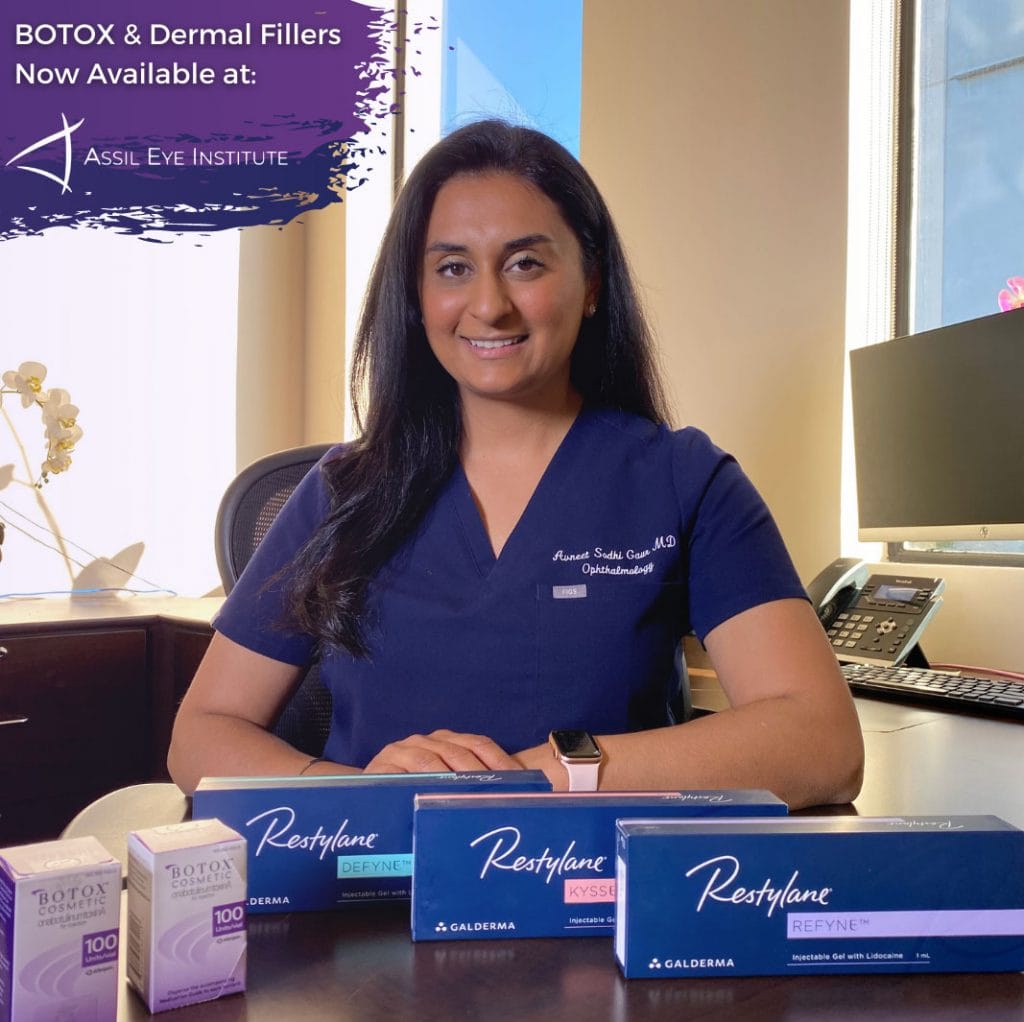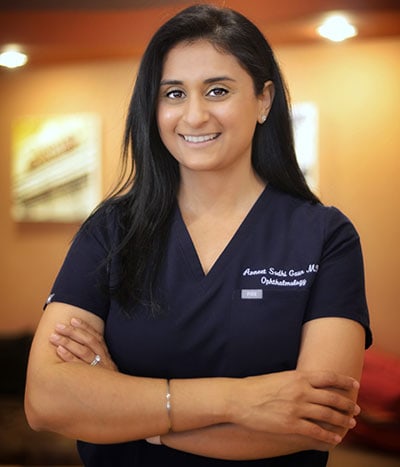
Dr. Avneet K. Sodhi Gaur, a board-certified ophthalmologist and glaucoma, cataract, and LASIK specialist, is now bringing her passion for aesthetics into the Assil Gaur Eye Institute.
Effective immediately, she is accepting patients for Botox and filler injection rejuvenation treatments at the Assil Gaur Eye Institute (AGEI) locations in Beverly Hills and Santa Monica, California.
Dr. Sodhi Gaur and aesthetics: following her passion
“It was time to officially expand my practice into the aesthetic side of the eyes and face, something that has been a passion of mine for years,” says Dr. Sodhi Gaur. She has served as Director of Glaucoma at AGEI since 2018.
With her extensive training in all aspects of a person’s eyes and face, she deeply understands the workings of every muscle, artery, and bone.
“It’s critically important that anyone using Botox and fillers is medically trained in every feature of a person’s face,” says Sodhi Gaur.
What can Botox and Dermal Fillers do for you?
Botox Cosmetic’s anti-aging cosmetic treatments are used in several areas of the face. Short of having a facelift, it is the most effective skincare option to reduce the signs of aging. This is done by reducing or eliminating fine lines, creases, crow’s feet, eyebrow lines, and bags under the eyes. It can also be used to treat migraines and TMJ (temporomandibular joint disfunction), among other conditions. All with no downtime.
Injectable dermal fillers (such as Restylane, Juvederm, Juvederm Ultra, Radiesse, Sculptra, Voluma, and Perlane) can reduce or eliminate deep smile lines, nasolabial folds, add volume to lips (lip augmentation) and jawlines, and fill other areas that have suffered facial volume loss. Also, with no downtime.
Botox’s roots in Ophthalmology
Since the FDA approved Botox (botulinum toxin) in 1989, its applications have seemed endless. However, most people only equate its use with plastic and cosmetic surgeons. But that is far from the truth! Botox has deep ophthalmology roots.
Ophthalmologists have treated disorders, including eyelid spastic disorders, with Botox for years. Ophthalmologists have thorough knowledge of the structure, muscle tissue, and skin elasticity of the face. Their extensive understanding of the face and eyes makes them experts in giving their patients the best facial rejuvenation results with Botox.
Clinical Uses of Botox in Ophthalmology
The uses of Botox in ophthalmology (also called “Botox ophthalmology”) can be broadly classified into a few categories:
Eyelids
In the eyelid, it can treat blepharospasm (BEB), hemifacial spasm, apraxia of lid opening, or induce ptosis in lid retraction and exposure keratopathy.
For BEB, Botox injections relax the muscles and stop the spasms. In most cases, this treatment provides symptom relief.
Strabismus
Strabismus is a condition in which the eyes don’t properly align with each other when looking at something. For strabismus management, it can be injected into overacting muscles to realign the eyes.
Cosmetics
For cosmetics, it can be used to relax facial muscles and reduce wrinkles. Other indications include treatment of chronic dry eye, lacrimal hypersecretion, and even pain relief in the acute angle-closure attack.
Cosmetic Botox: minor risks and their prevention
Botox Cosmetic, which needs no anesthetic to use, does have some minor risks, such as:
- Pinpoint bleeding – the needle might nick a small capillary or vein, causing minor bleeding. Managed by pressure with a gauze pad.
- Injection site swelling – a bit of swelling or bruising around the injection site is common.
Avoided by applying ice immediately after injection.
- Injection site infection – when a needle breaks the skin, there is always a small risk of infection. Prevented by cleaning the skin with alcohol prior to injection.
- Diplopia – in rare instances, double-vision may occur after Botox injections near the eye. Prevented by avoiding the inferior oblique muscles.
- Ecchymosis – there is a small risk of the needle nicking a capillary causing bleeding under the skin. Patients should avoid anticoagulants (including aspirin, blood thinners, and large doses of vitamin E) for one or two weeks prior to injection. Also, apply ice immediately after injection.
- Ptosis – a rare side effect of Botox is drooping eyelids. Drooping eyelids generally resolve within two to three weeks on their own. The doctor may also administer 2.5% phenylephrine solution on the inside of the upper eyelid.
Injectable Fillers: mostly safe, with one rare but devastating complication
Having dermal fillers injected into the facial area is usually quite innocuous. Normal occurrences after injections of a facial filler include temporary redness at the injection site and a little temporary soreness and swelling.
Serious complications after cosmetic facial injections are very rare, but when they do happen, they are devastating.
Most people who have facial enhancement or contouring with injections may be unaware of the potentially permanent complication of facial injections: blindness.
Why does this happen? There are so many small blood vessels, specifically arteries, around the forehead and eyes that supply blood to the area. Improper use of dermal fillers in the forehead especially can lead to blockage of a blood vessel that supplies blood to the eye. When the blockage prevents blood from reaching the eye, blindness is the result. This condition is known as retinal artery occlusion (RAO).
Botox and Fillers with Dr. Sodhi Gaur: safety first

“One thing most patients don’t realize is every aesthetic practice or medical spa (also known as “med spas”) that uses Botox or fillers is required by law to have a board-certified medical doctor on staff and a board-certified ophthalmologist on call that can immediately refer to in case of an emergency (i.e. potential blindness). But many do not,” Dr. Sodhi Gaur says.
That is obviously not the case with Dr. Sodhi Gaur.
The benefit for patients having a highly trained doctor like Dr. Sodhi Gaur performing their aesthetic procedures is obvious: exceptional results and unparalleled safety. In the rare occurrence of any side effects or complications, she can promptly and effectively treat them herself, rather than the patient waiting and having to be referring out. She has the expertise, thus the risk of any side effects is greatly reduced.
Why Choose Dr. Sodhi Gaur and Assil Gaur Eye Institute for facial aesthetic treatments
Dr. Avneet K. Sodhi Gaur is a Board-Certified Ophthalmologist and world-class Glaucoma Specialist and Cataract and LASIK surgeon.
Her experience and knowledge of the eye and facial structures are unparalleled, and her clinics are state-of-the-art medical facilities. Her goal is to help you achieve your personal best, be it with your look or vision, with the hands of a master surgeon.
Please call 866-945-2745 or visit us here to make an appointment online for a consultation.
At Assil Eve Institute we take our patients’ safety seriously. Our facility’s Covid-19 patient safety procedures exceed all CDC recommendations. Masks are required in our institutes at all times.
We are conveniently located for those throughout the Los Angeles area. Our ophthalmologists are available at locations in or near Santa Monica and Wilshire Blvd. in Beverly Hills. We are conveniently located near West Los Angeles, Culver City, West Hollywood, Downtown Los Angeles, Marina del Rey, Pacific Palisades, Malibu, Manhattan Beach, Sherman Oaks, and Encino.













